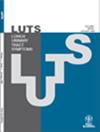Utilization and safety of telemedicine for pediatric lower urinary tract symptoms before and during the COVID-19 pandemic
Abstract
Objectives
Telemedicine for pediatric lower urinary tract symptoms (pLUTS) is a relatively new mode of delivering bladder health education with scant evidence supporting current practice. We aim to examine the safety of pLUTS-related telemedicine visits surrounding the COVID-19 pandemic.
Methods
We conducted a retrospective cohort study of new pLUTS referral diagnoses to our institution's pediatric urology clinics. Demographics, wait times, and referral diagnoses were captured and compared before and after March 2020 using χ2/Fisher exact tests and t-tests. A retrospective chart review was performed for an initial telemedicine visit followed by an in-person visit to identify missed radiology, lab, or physical exam findings.
Results
Six hundred twelve patients were included from September 2018 to August 2021. Most were 5–10 years old (62.3%), female (56.2%), English speaking (86.5%), White (39.4%), and had private insurance (67.2%). Wait times were shorter for telemedicine versus in-person visits (t190 = −3.56, p < .001). After March 2020, patients with a urinary tract infection (UTI) and females utilized in-person visits more often (p < .001). After chart review (11 patients, mean = 10.4 years), 9 (81.8%) had comorbid conditions and/or family history of lower urinary tract symptoms. None had missed clinical findings that changed management.
Conclusions
pLUTS care can be delivered via telemedicine without a significant change in patient volume and population, though additional investigations will clarify the needs of patients with specific referral diagnoses and comorbid conditions. The in-person exam can be omitted safely with proper clinical history taking, supporting future virtual programs that address delays in care within local communities.

 求助内容:
求助内容: 应助结果提醒方式:
应助结果提醒方式:


